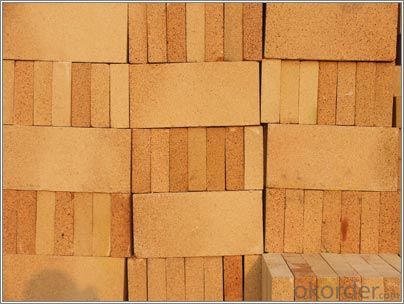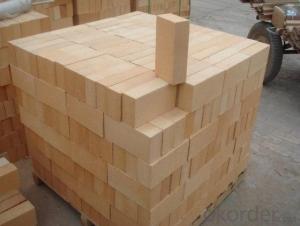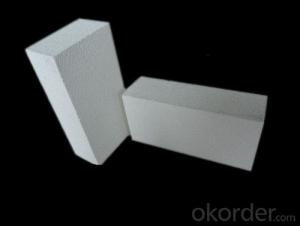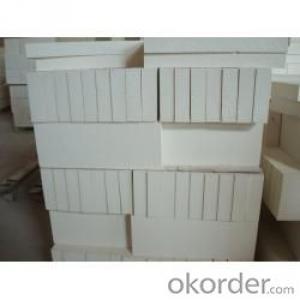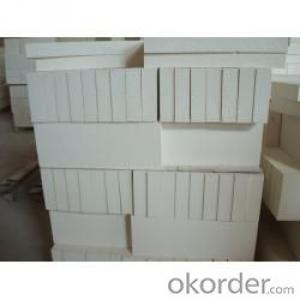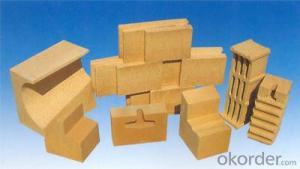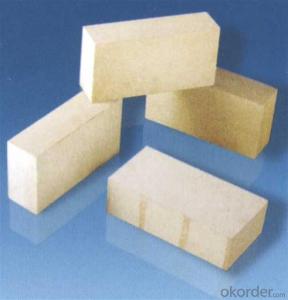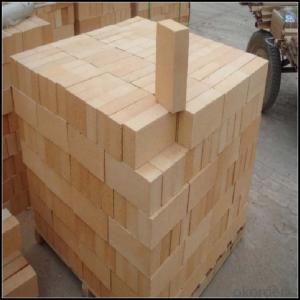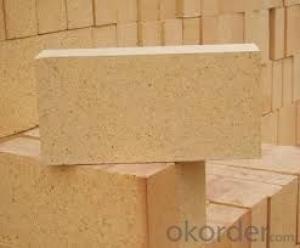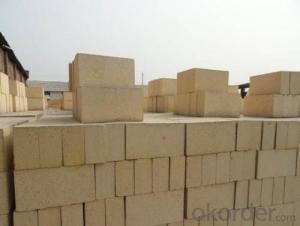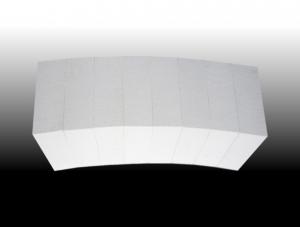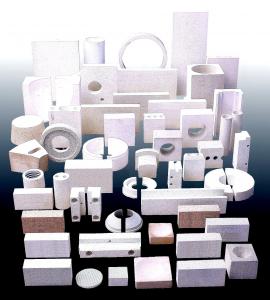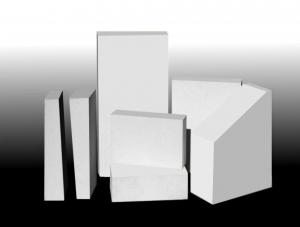High Alumina Insulating Fire Brick
- Loading Port:
- China Main Port
- Payment Terms:
- TT OR LC
- Min Order Qty:
- -
- Supply Capability:
- -
OKorder Service Pledge
OKorder Financial Service
You Might Also Like
Specifications
Fire brick1.ISO 9001 approved,
2.With high quality and competitive price,
3.Standard and special shape.
Fire-clay refractory brick.
1. N-1
AL2O3 (%)>42
Refractoriness >1750
Refractoriness under load KD>1400
Permanent linear change onreheating
1500*2h
1450*2h
1400*2h:+0.1; -0.4
Apparent Porosity(%)<22
Cold crushing strength (Mpa)>29.4
2. N-2a
AL2O3 (%)>40
Refractoriness >1730
Refractoriness under load KD>1350
Permanent linear change onreheating
1500*2h
1450*2h
1400*2h:+0.1; -0.5
Apparent Porosity(%)<24
Cold crushing strength (Mpa)>24.5
High-alumina refractory brick
1. LZ-75
AL2O3 (%)>75
Refractoriness>1790
Refractoriness under load KD>1520
Permanent linear change onreheating
1500*2h:+0.1; -0.4
1450*2h
1400*2h
Apparent Porosity(%)<23
Cold crushing strength (Mpa)>53.9
2. LZ-65
AL2O3 (%)>65
Refractoriness >1790
Refractoriness under load KD>1500
Permanent linear change onreheating
1500*2h:+0.1; -0.4
1450*2h
1400*2h
Apparent Porosity(%)<23
Cold crushing strength (Mpa)>49
3.LZ-55
AL2O3 (%)>55
Refractoriness >1770
Refractoriness under load KD>1470
Permanent linear change onreheating
1500*2h:+0.1; -0.4
1450*2h
1400*2h
Apparent Porosity(%)<22
Cold crushing strength (Mpa)>44.1
4.LZ-48
AL2O3 (%)>48
Refractoriness >1750
Refractoriness under load KD>1420
Permanent linear change onreheating
1500*2h
1450*2h:+0.1; -0.4
1400*2h
Apparent Porosity(%)<22
Cold crushing strength (Mpa)>39.2
Fire clay brick SK-32 | |
Item | Standard |
AI2O3(%) | 30 |
Fe2O3 (%) | 3.5 |
Refractoriness (SK) | 32 |
Refractoriness under load, 0.2MPa, Ta, (°C) | 1300 |
Porosity (%) | 22-26 |
Bulk density (g/cm³) | 2.05 |
Cold crushing strength (MPa) | 25 |
Thermal expansion at 1000°C (%) | 0.6 |
Fire clay brick SK-34 | |
Item | Standard |
AI2O3(%) | 38 |
Fe2O3 (%) | 2.5 |
Refractoriness (SK) | 34 |
Refractoriness under load, 0.2MPa, Ta, (°C) | 1350 |
Porosity (%) | 19-23 |
Bulk density (g/cm³) | 2.10-2.15 |
Cold crushing strength (MPa) | 25 |
Thermal expansion at 1000°C (%) | 0.6 |
Fire clay brick SK-36 | |
Item | Standard |
AI2O3(%) | 50 |
Fe2O3 (%) | 2 |
Refractoriness (SK) | 36 |
Refractoriness under load, 0.2MPa, Ta, (°C) | 1450 |
Porosity (%) | 20-24 |
Bulk density (g/cm³) | 2.30-2.40 |
Cold crushing strength (MPa) | 45 |
Thermal expansion at 1000°C (%) | 0.3 |
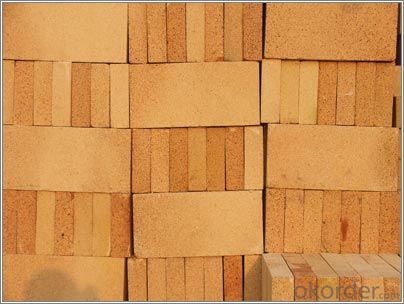
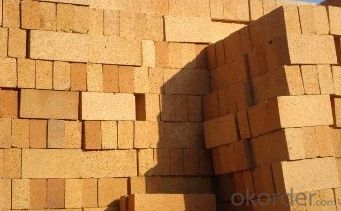
- Q: Can insulating fire bricks be used in waste incineration plants?
- Yes, insulating fire bricks can be used in waste incineration plants. These bricks are designed to withstand high temperatures, making them suitable for lining the combustion chambers and other areas where intense heat is generated in waste incinerators. Additionally, their insulating properties help to reduce heat loss and increase energy efficiency in the incineration process.
- Q: Do insulating fire bricks have a low density?
- Yes, insulating fire bricks have a low density compared to other types of bricks. These bricks are designed to have a porous structure, which helps in reducing heat transfer and increasing insulation properties. The low density of insulating fire bricks allows them to provide effective thermal insulation while also being lightweight. This makes them suitable for various applications where heat retention and energy efficiency are important, such as in kilns, furnaces, and fireplaces.
- Q: How long do insulating fire bricks last?
- Insulating fire bricks are designed to withstand high temperatures and provide excellent insulation properties. The lifespan of insulating fire bricks can vary depending on several factors such as the quality of the bricks, the temperature they are exposed to, and how well they are maintained. Generally, insulating fire bricks can last for several years, often ranging from 10 to 20 years or even longer. However, it is important to note that the lifespan can be significantly reduced if the bricks are exposed to extreme temperatures or thermal shock on a regular basis. Regular maintenance and proper usage can also extend the lifespan of insulating fire bricks. This includes regular cleaning to remove any debris or build-up that can impact their performance. It is also important to avoid sudden temperature changes or excessive stress on the bricks, as this can lead to cracking or damage. Overall, the longevity of insulating fire bricks can vary, but with proper care and maintenance, they can provide reliable insulation for many years in high-temperature applications.
- Q: Are insulating fire bricks resistant to nitrogen oxides?
- Insulating fire bricks are known for their excellent thermal insulation properties and are commonly used in high-temperature applications such as furnaces, kilns, and industrial boilers. While they are highly resistant to heat and can withstand extreme temperatures, their resistance to nitrogen oxides (NOx) may vary depending on the specific composition and manufacturing process of the bricks. Nitrogen oxides are a group of harmful gases that are produced during combustion processes, particularly at high temperatures. These gases can have detrimental effects on human health and the environment. Although insulating fire bricks have a high melting point and can withstand intense heat, they may not provide sufficient resistance to nitrogen oxides on their own. To enhance the resistance of insulating fire bricks to nitrogen oxides, additional measures and coatings may be required. These could include the use of specialized refractory coatings or the incorporation of specific additives during the manufacturing process to create a more chemically resistant brick. It is important to note that the resistance of insulating fire bricks to nitrogen oxides may also depend on the specific application and operating conditions. Different types of nitrogen oxides, such as nitrogen dioxide (NO2) or nitric oxide (NO), may have different effects on the bricks. Therefore, it is recommended to consult the manufacturer or a specialist in refractory materials to determine the suitability of insulating fire bricks in a specific environment where the presence of nitrogen oxides is a concern.
- Q: Do insulating fire bricks have a high insulation efficiency?
- Indeed, the insulation effectiveness of insulating fire bricks is quite high. These bricks are specifically engineered to possess exceptional thermal insulation properties. They are crafted from lightweight materials with low thermal conductivity, such as various types of refractory clay or alumina. This composition enables them to effectively minimize heat transfer via conduction, thereby making them exceedingly efficient at retaining heat within structures or appliances. Additionally, insulating fire bricks exhibit considerable porosity, which amplifies their insulation capabilities even further. The presence of numerous small air pockets within the bricks diminishes heat transfer through convection, as the air acts as an insulating barrier. This distinct structure aids in maintaining a constant and stable temperature, regardless of whether it is within a furnace, kiln, or any other high-temperature setting. Furthermore, insulating fire bricks possess remarkable resistance to thermal shock, allowing them to endure rapid temperature changes without fracturing or deteriorating. This attribute is particularly vital in applications where temperature fluctuations are commonplace, as it guarantees the longevity and effectiveness of the insulation. In summary, insulating fire bricks are renowned for their exceptional insulation efficiency. They offer superb thermal insulation, prevent heat loss, and contribute to energy conservation. Whether utilized in industrial environments or residential constructions, these bricks deliver reliable insulation performance and enhance the overall energy efficiency of the system in which they are employed.
- Q: Can insulating fire bricks be used as a backup insulation material?
- Yes, insulating fire bricks can be used as a backup insulation material. Insulating fire bricks are designed to have low thermal conductivity, which means they are effective at reducing heat transfer. This makes them suitable for use as a backup insulation material in applications where maintaining temperature stability is crucial. They are commonly used in industrial furnaces, kilns, and other high-temperature environments where the primary insulation material may fail or need additional support. Insulating fire bricks can provide an extra layer of insulation, helping to prevent heat loss and improve energy efficiency. Additionally, they are durable and able to withstand high temperatures, making them a reliable choice for backup insulation.
- Q: Can insulating fire bricks be used in the construction of combustion flues?
- Yes, insulating fire bricks can be used in the construction of combustion flues. Insulating fire bricks are designed to withstand high temperatures and are often used to line combustion chambers and flues to provide insulation and prevent heat loss. They have excellent thermal properties, making them suitable for this purpose.
- Q: Are insulating fire bricks suitable for use in the construction of blast furnaces?
- Insulating fire bricks, crafted from lightweight materials like ceramics, prove to be a suitable option for blast furnace construction. These bricks possess remarkable insulating properties and exhibit low thermal conductivity. This quality aids in minimizing heat loss and optimizing efficiency within the blast furnace. Moreover, insulating fire bricks boast exceptional resistance to thermal shock, allowing them to endure sudden temperature fluctuations without any cracks or breaks. This attribute is vital in blast furnace construction, considering the intense heat that can rapidly deteriorate traditional bricks. Additionally, insulating fire bricks display high compressive strength, guaranteeing their durability and longevity amidst the harsh conditions of a blast furnace. In conclusion, incorporating insulating fire bricks in blast furnace construction not only enhances energy efficiency but also elevates furnace performance, ultimately extending its lifespan.
- Q: Can insulating fire bricks be used in the construction of coke ovens?
- The use of insulating fire bricks in the construction of coke ovens is indeed possible. These bricks are specifically designed to endure extreme temperatures and offer exceptional thermal insulation. Coke ovens, which typically operate at around 2000 degrees Fahrenheit, necessitate materials that can withstand such conditions. The low thermal conductivity of insulating fire bricks effectively hinders heat transfer between the interior and exterior of the oven. This feature helps to maintain the necessary high temperatures for coal carbonization in the coke oven, while simultaneously minimizing heat loss. Moreover, insulating fire bricks possess a lightweight composition and high strength, which makes them ideal for coke oven construction. Their lightweight nature facilitates easier installation and reduces the overall weight of the structure. Additionally, their high strength ensures that they can endure the harsh operating conditions of the coke oven without cracking or crumbling. In conclusion, insulating fire bricks are a suitable choice for constructing coke ovens due to their ability to withstand high temperatures, provide thermal insulation, and offer durability.
- Q: Can insulating fire bricks be used for insulation in boilers?
- Yes, insulating fire bricks can be used for insulation in boilers. These bricks are designed to withstand high temperatures and are highly effective in retaining heat, making them suitable for insulating the walls and floors of boilers.
Send your message to us
High Alumina Insulating Fire Brick
- Loading Port:
- China Main Port
- Payment Terms:
- TT OR LC
- Min Order Qty:
- -
- Supply Capability:
- -
OKorder Service Pledge
OKorder Financial Service
Similar products
Hot products
Hot Searches
Related keywords




